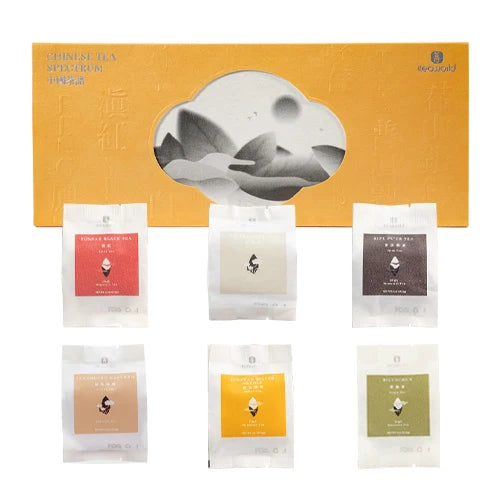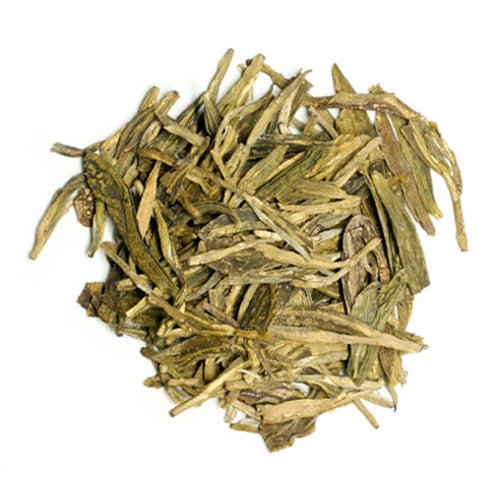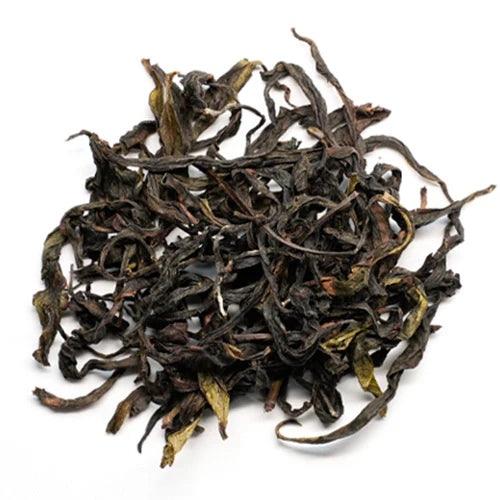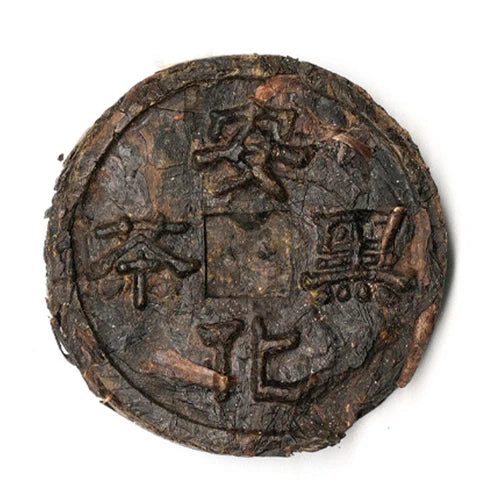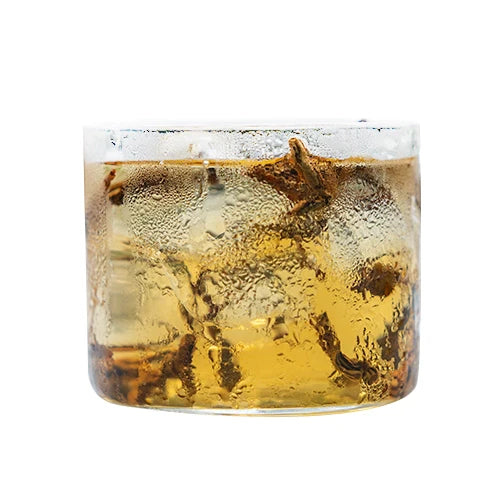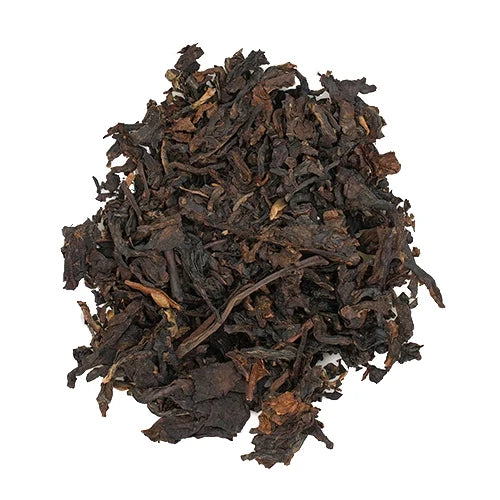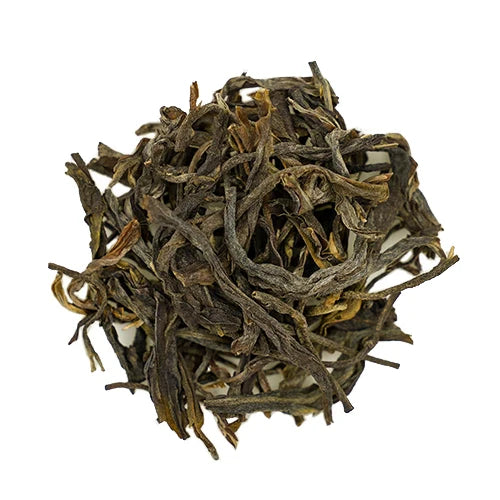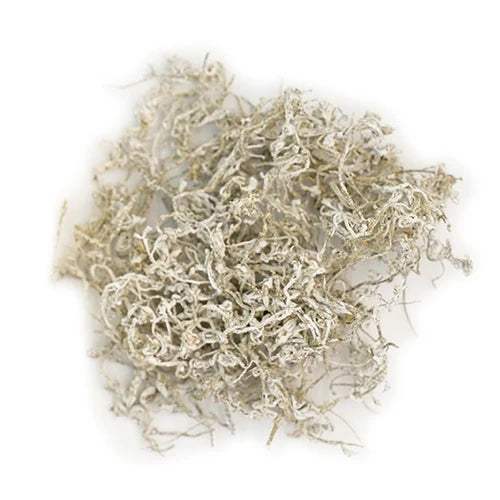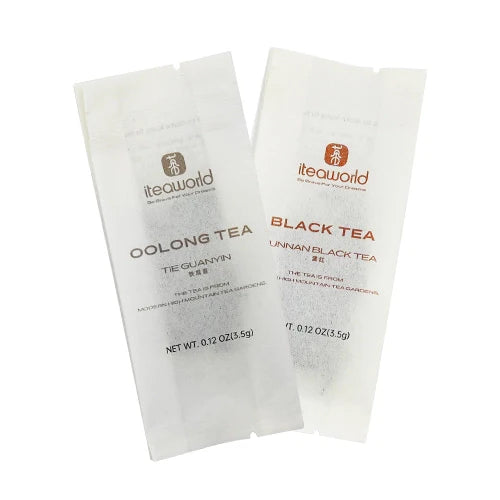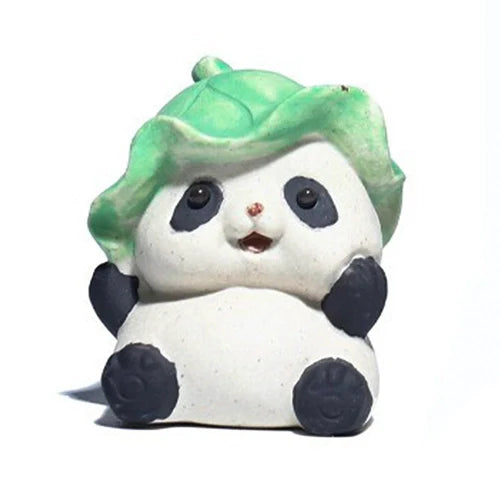Step 1 Start Your oolong journey: Top 10 classics for Beginners
If you’re new to Chinese oolong tea, I recommend starting with the most representative and famous varieties—at a minimal cost but with reliable quality. Good quality is essential, so that your first experience with oolong is enjoyable and authentic.
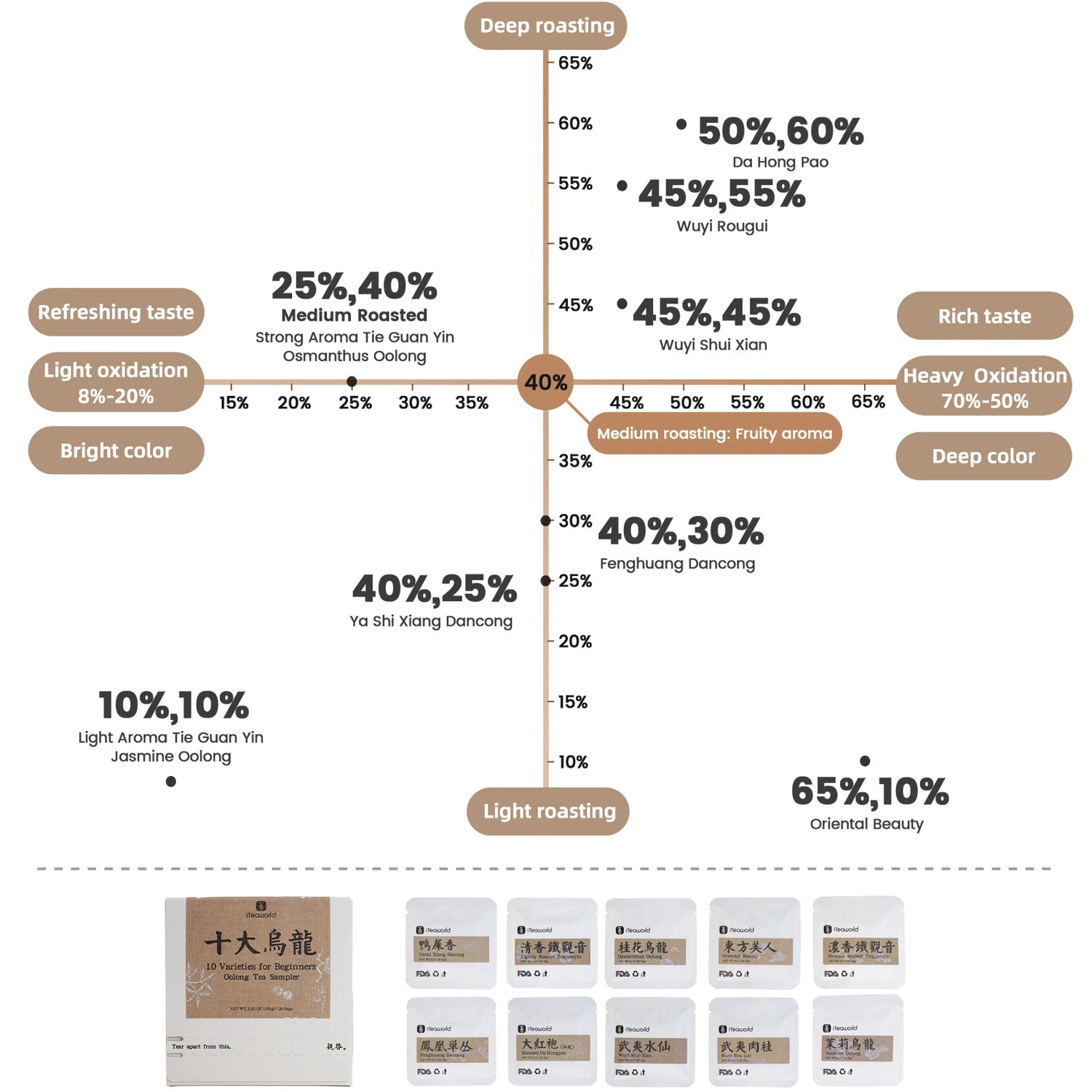

Шаг 1: Начните с коллекции 10 лучших улунов Китая
Лучше всего начать с этой «Коллекции из 10 лучших улунов». Это своего рода карта вкусов китайского чая улун, дающая вам возможность попробовать самые культовые стили в одном наборе:
- Те Гуань Инь – самый известный улун Китая, доступный как в легкой, так и в насыщенной обжарке.
- Да Хун Пао, Роу Гуй, Шуй Сянь – классические каменные чаи Уи, насыщенные минералами.
- Я Ши Сян, Ми Лань Сян – ароматные улуны с горы Феникс в провинции Гуандун.
- Османтусовый и жасминовый улун – натуральные цветочные чаи с нежным ароматом.
Этот набор позволит вам изучить основные разновидности китайского улуна с минимальными затратами и максимальным разнообразием.
Step 2 Discover the Regions: Where Oolong is Born
Oolong tea is shaped by its birthplace. In China, four main regions define its character: Wuyi (Northern Fujian), Anxi & Yongchun (Southern Fujian), Chaozhou Phoenix Mountain (Guangdong), and Taiwan. From its 17th-century beginnings in Wuyi, oolong spread to Anxi, then to Guangdong, and by the late 18th century to Taiwan. Over time, each region developed its own craft and flavors, yet all remain connected through shared history. We’ve curated three regional collections (currently excluding Taiwan) to help you explore oolong’s origins and taste the differences for yourself..


Первая остановка: Южный Фуцзяньский улун — слабоферментированный и с разнообразными вкусами
Южная провинция Фуцзянь – вторая родина улуна, известного своим широким разнообразием стилей – от лёгкой до сильной обжарки, с цветочными и фруктовыми ароматами – что позволяет новичкам легко заметить разницу. В конце XVII века методы заваривания чая из Уи распространились в Аньси и, слившись с местными традициями, привели к появлению характерного чая Те Гуань Инь . Изначально сильно обжаренный и в основном предназначенный на экспорт, в 1990-х годах под влиянием тайваньского чая с лёгким ароматом он перешёл к более лёгкому, цветочному Те Гуань Инь, популярному сегодня.
Южнофуцзяньские улуны разнообразны: традиционные виды обжарки (Те Гуань Инь, Юнчунь Фо Шоу), свежие цветочные чаи (Хуан Цзинь Гуй, Бай Я Цилань), прессованные улуны (Чжанпин Шуй Сянь) и крупнолистовые улуны с карамельным ароматом . Мы собрали коллекцию южнофуцзяньских улунов, включающую 8 местных сортов и знаменитые чаи, демонстрирующих 400-летнюю историю развития региональных вкусов.


Вторая остановка: Гуандунский улун, где каждое дерево имеет свой собственный аромат
На горе Фэнхуан в Чаочжоу улун приобретает поистине уникальную форму. Гуандунский улун отличается насыщенным ароматом, средней степенью окисления и средней обжаркой, а также раскрывает характерный аромат каждого сорта.
Здесь чай собирают с отдельных деревьев — традиция, называемая Даньцун, где каждое дерево может источать уникальный аромат: медовая орхидея, магнолия, гардения, цветок имбиря, цветущий ночью жасмин...
Наша коллекция гуандунских улунов охватывает всю историю региона — от древних улунов «Фэнхуан Шуйсянь» и «Шигупин» до современных звёзд, таких как «Утиное дерьмо» (Я Шисян) и «Ми Ланьсян», а также других классических сортов. Это идеальный способ понять, почему гуандунский улун — одна из самых очаровательных чайных традиций Китая.


Финальная остановка: улун из Северной Фуцзянь — сила «рок-рифмы»
Горы Уи — родина улуна и объект Всемирного культурного и природного наследия ЮНЕСКО. Их крутые скалы и густые леса создают уникальный «янь юнь» (стихотворение гор) — многослойный вкус, присущий только этому особому терруару.
С XVII века уишанский чай эволюционировал от зелёного чая к полуферментированному улуну, положив начало современной всемирно известной традиции чая из скалы Уишань. Чай из скалы Уишань, признанный нематериальным культурным наследием, известен своей крепкой обжаркой, насыщенным вкусом и глубоким многогранным ароматом.
В этой коллекции собраны самые яркие сорта чая из Северной Фуцзяни — от чаев, берущих начало в эпоху династии Сун, до перспективных современных сортов. Каждый из них отражает мастерство региона и рассказывает свою историю, предлагая вам по-настоящему ощутить характер и многообразие Северной Фуцзяни.
Step 3 Dive Deep into Famous Teas: Wuyi Rock Tea & Fenghuang Dancong
lf you know teas like Longjing, Wuyi Rock Tea, or Jasmine Green Tea, you've probably noticed two things: their prices can vary wildly, and they can come from different regions and even different cultivars. Covering them all at once would be overwhelming, so here we'll focus on two of the most renowned oolongs - Wuyi Rock Tea and Fenghuang Dancong- and introduce you to their core varieties.


Чай из скалы Уи: основные сорта
Если вы ищете коллекцию, с которой можно начать своё путешествие по Уишаньскому утесу, то это она. Мы включили три самых культовых чая — Да Хун Пао, Шуйсянь и Жуй — каждый со сравнительными вариантами, которые помогут вам понять их уникальные особенности.
Да Хун Пао: как чистые сорта (например, Цидань и Цюэ Шэ), так и смешанные коммерческие версии.
Шуйсянь: как молодые кусты (синьцун), так и старые кусты (лаоцун), поэтому вы сможете ощутить всю глубину «вкуса цуна».
Rougui: вина из терруаров «полукамень» и «настоящая скала», демонстрирующие характерную для Rougui пряную интенсивность.
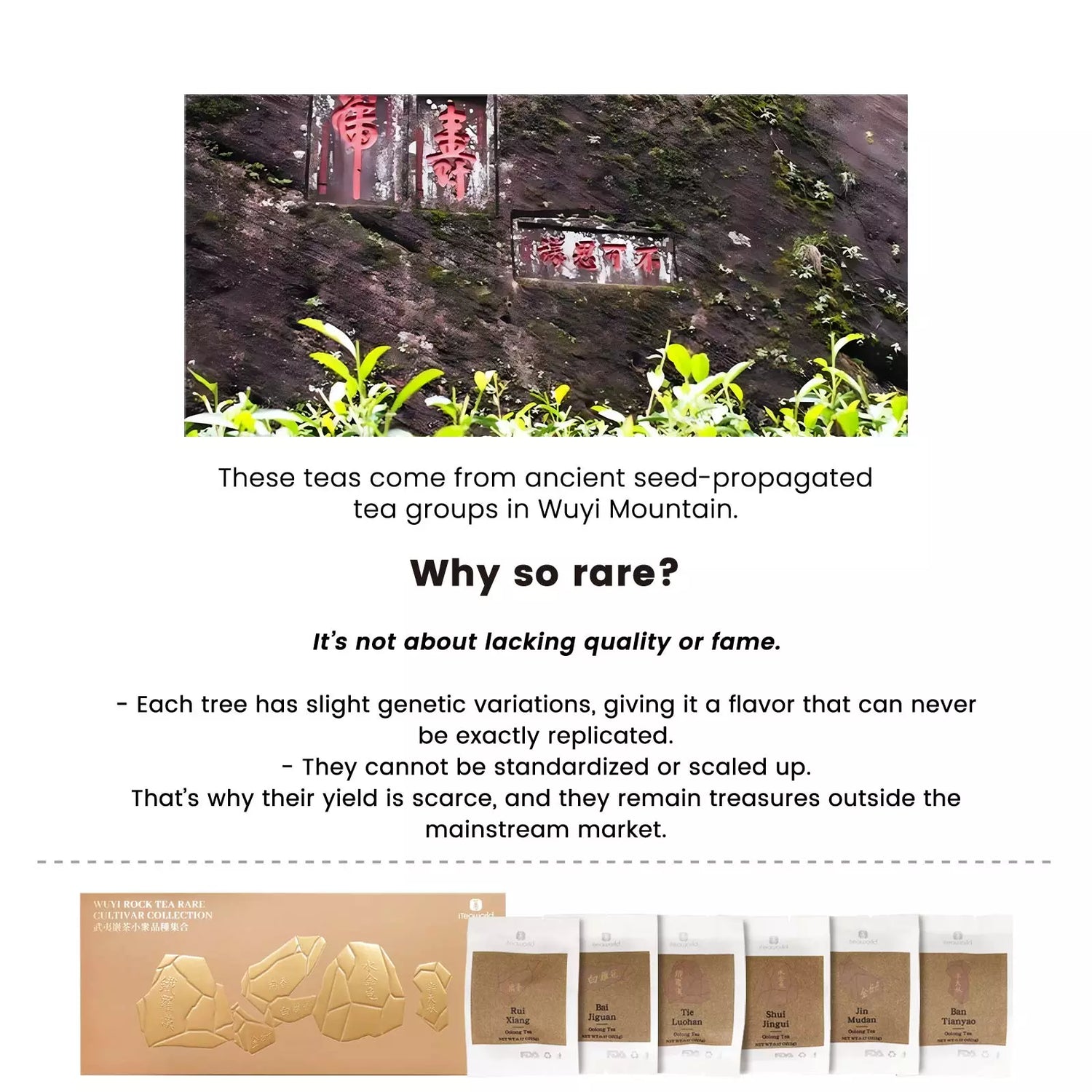

3.2 Wuyi Rock Tea Rare Varieties Collection
If you’ve already explored classic Wuyi teas like Da Hong Pao, Rou Gui, and Shui Xian, this set invites you to go deeper into the rare and traditional side of Wuyi rock tea.
It includes unique varieties such as Tie Luo Han, Bai Ji Guan, Shui Jin Gui, Ban Tian Yao, Rui Xiang, and Jin Mu Dan—all originating from centuries-old tea bushes in the core Wuyi mountains. These teas preserve the ancient genes of rock tea and offer flavors you won’t find in the mainstream classics.
Highlights of their flavor profiles:
- Bai Ji Guan – sweet and refreshing, with notes of corn silk
- Tie Luo Han – rich herbal aroma, reminiscent of traditional Chinese medicine
- Ban Tian Yao – exotic blend of gardenia, milk, and honeyed floral notes
- Rui Xiang – highly penetrating fragrance, treasured as a “secret weapon” in premium blends
With very limited production (Ban Tian Yao yields less than 100 pounds per year), these teas are sought after by seasoned tea lovers and collectors. This collection lets you experience the diversity of Wuyi craftsmanship and terroir through its rarest cultivars.


Коллекция фирменных ароматов Fenghuang DancongTen
Если вы уже пробовали Даньцун, скорее всего, это был либо «Ми Лань Сян» (с ароматом медовой орхидеи), либо «Я Ши Сян» (с ароматом утиного помёта). Чтобы по-настоящему оценить всю гамму его натуральных ароматов, попробуйте коллекцию «Десять ароматов».
Каждый чай в этом наборе собран в основном районе выращивания Даньцун, в городе Фэнхуан, на средней или более высокой высоте, где более низкие температуры и плодородные почвы позволяют добиться самых интенсивных и изысканных ароматов. Некоторые из самых редких сортов чая крайне сложно найти, а их годовой объём производства весьма ограничен.
Step 4 Side-by-Side Comparisons: Understanding Oolong on a Deeper Level
Once you've built a solid foundation, you might start wondering: What exactly shapes the flavor of oolong tea?Is high-altitude tea really better than low-altitude tea?How does a spring-harvest oolong differ from an autumn-harvest one?Does a century-old tea tree produce a richer tea than a young one?To answer these questions, we created our “Variable-Control Exploration Series”.This series lets you compare teas where only one factor changes at a time - so you can isolate and taste the impact of each variable.
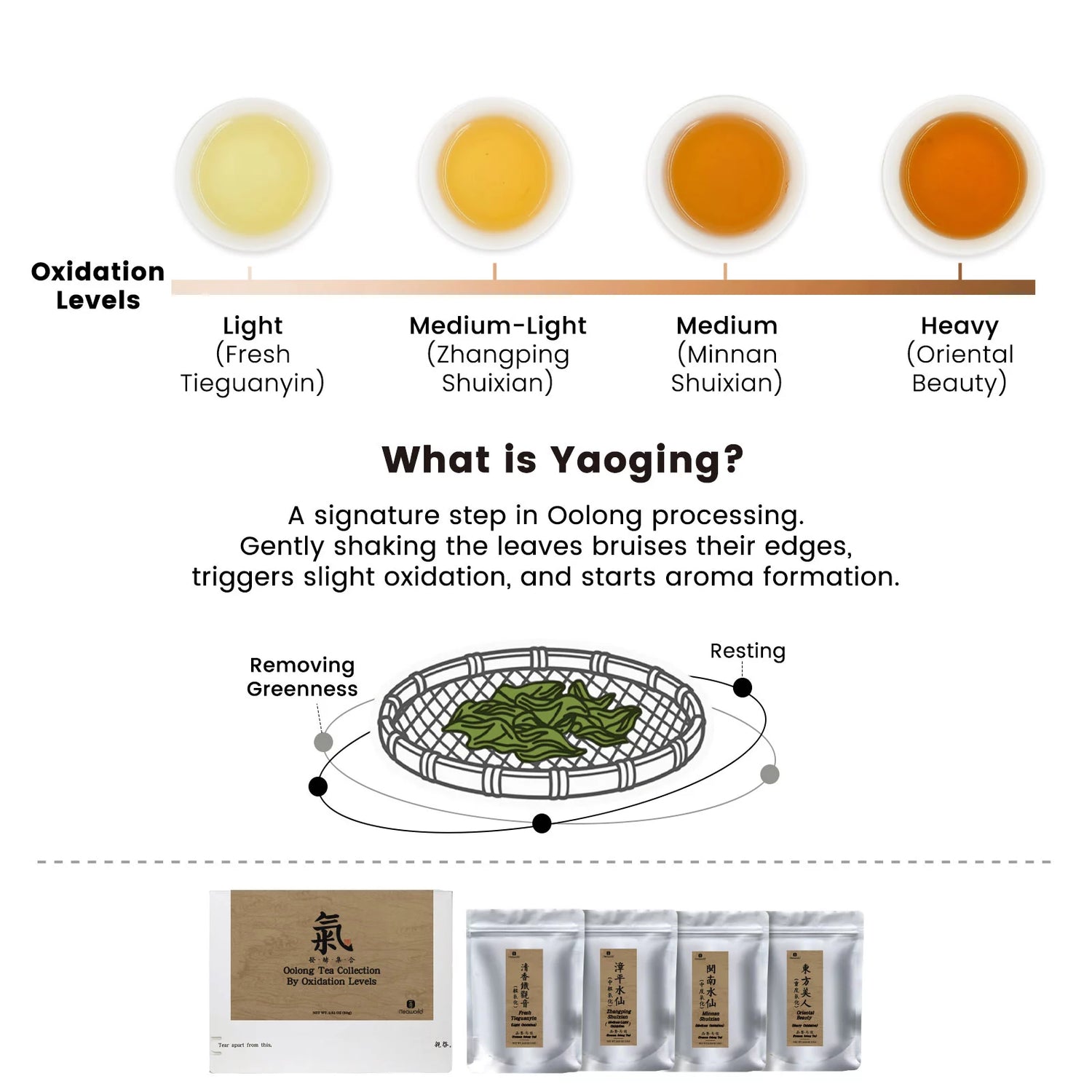

What’s the Difference Between Oolong Teas at Different Oxidation Levels?
В чем разница между чаями улун разной степени окисления?
Улун — это полуферментированный чай, степень окисления которого колеблется от 10% до 70%. Именно окисление в основном формирует аромат и вкус:
- Слабое окисление (10–25%): свежие, цветочные и фруктовые ноты. Примеры: Вэньшань Баочжун, лёгкий Те Гуань Инь.
- Умеренная степень окисления (25–50%): цветочные ноты, смешанные с ароматами меда, фруктов или жареных специй. Сбалансированный и сложный. Примеры: Феникс Данцун, насыщенный Те Гуань Инь.
- Высокая степень окисления (50–70%): ароматы спелых фруктов, жареных или карамельных оттенков, мягкий, сочный вкус. Примеры: Да Хун Пао, Уи Жоу Гуй, Восточная Красавица.
В нашу коллекцию улунов по уровням окисления входят четыре знаменитых чая, все легкой обжарки, но с разной степенью окисления, что позволяет вам ощутить, как окисление преображает вкус.


Does Heavily Roasted Oolong Always Taste Smoky?
Всегда ли сильно обжаренный улун имеет дымный привкус?
Обжарка улуна нужна не только для вкуса — она также уменьшает влажность, устраняет нежелательные ноты и снижает содержание кофеина. Степень обжарки часто влияет на окисление:
Легкая обжарка сохраняет свежесть и цветочный аромат чая.
Сильная обжарка делает напиток более полным, с нотками поджаренного хлеба или угля.
Если слегка окисленный чай обжарить слишком сильно, сильный привкус прожарки может перебить его естественный вкус.
В нашу коллекцию улунов Wuyi Rougui от Roast Levels входят чаи из одного региона и от одного мастера, но с разной степенью обжарки, чтобы вы могли изучить, как обжарка формирует вкус.
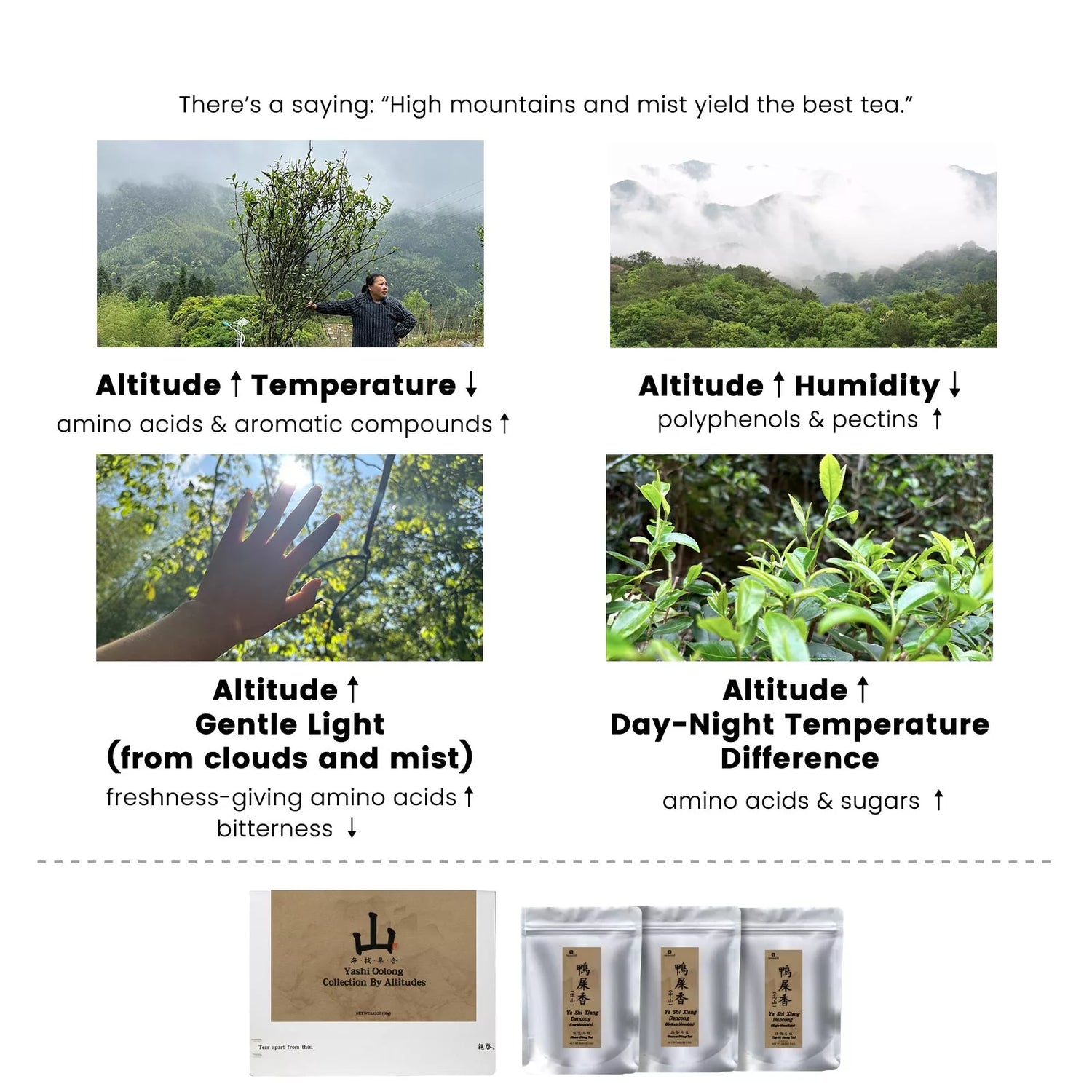

Is High-Altitude Tea Worth It? This Product Might Give You the Answer
Стоит ли покупать высокогорный чай? Этот продукт может дать вам ответ.
В высокогорных районах климат более прохладный, разница дневных и ночных температур большая, а туманы частые. Эти условия замедляют рост листьев, что приводит к повышению уровня теанина и обогащению его соединениями, благодаря чему чай становится более сладким, свежим и ароматным. Такие чаи обычно подвергаются лёгкой или средней степени окисления и обжарки. Примеры: Тайваньский высокогорный чай, Феникс Данцун.
Напротив, чаи, произрастающие на низких высотах, часто содержат больше полифенолов, имеют более слабый аромат и менее стойки после многократных завариваний.
Наша коллекция улунов Я Ши Сян Дань Цун от Altitudes включает три чая из одного региона, созданные одним и тем же мастером, но выращенные на разных высотах, что позволяет вам напрямую сравнить, как высота влияет на вкус.
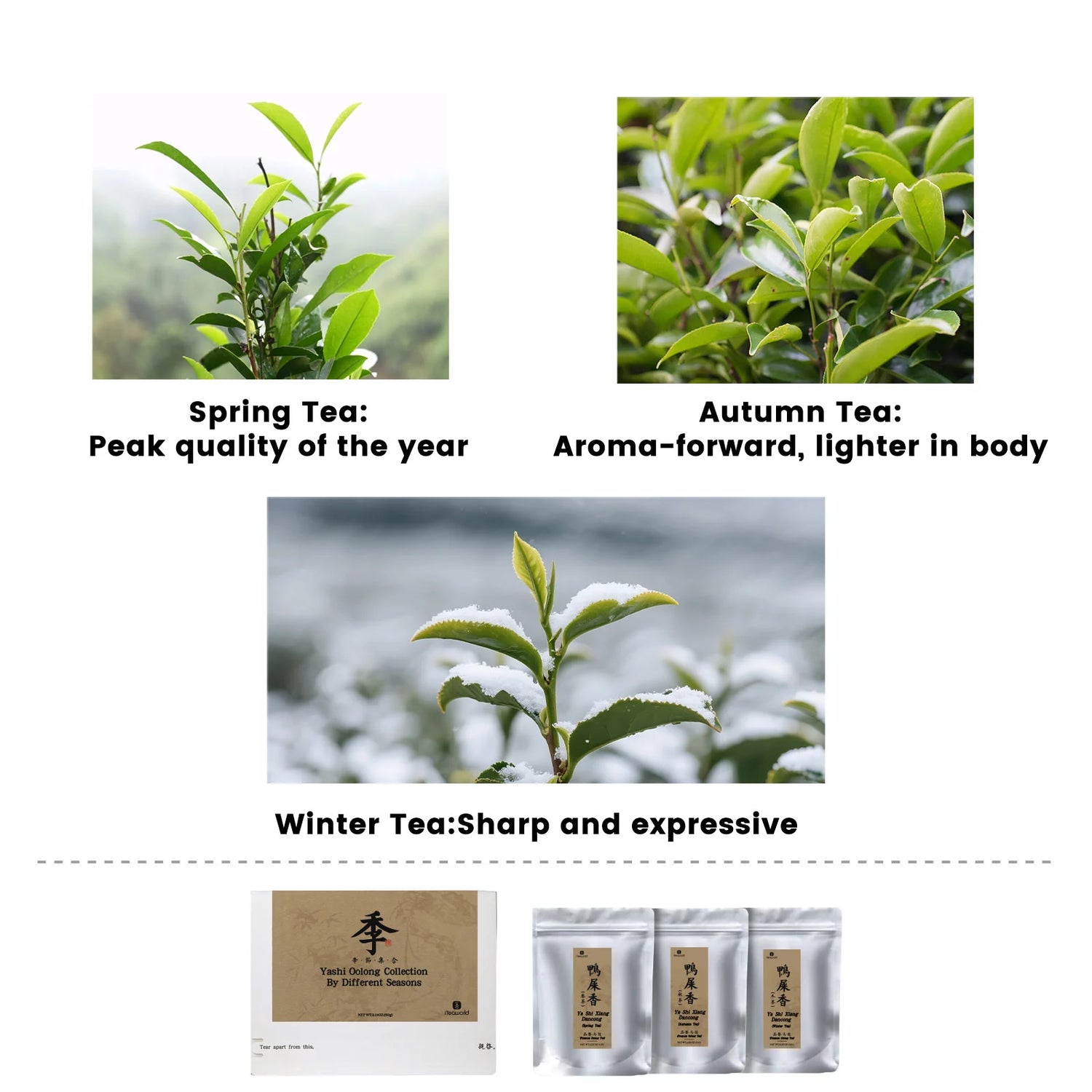

Is spring Tea the Best for Oolong? Just Like Green Tea?
Весенний чай — лучший для улуна? Как и зелёный чай?
Улун можно собирать весной, летом, осенью и зимой. Однако чай с утеса Уи собирают только весной.
Весенние чаи растут медленно, богаты аминокислотами и полифенолами, имеют сладкий и насыщенный вкус, но частые дожди могут ослабить аромат.
Осенние и зимние чаи часто имеют более сильный и свежий аромат.
Летние чаи обычно используются для приготовления молочного чая и редко продаются в рассыпном виде.
В нашей коллекции улунов «Я Ши Сян Дань Цун» от Seasons представлены три чая из одной деревни и от одного мастера, собранные в разные сезоны. Каждый из них имеет степень ферментации и обжарки, соответствующую типу листа: подобно зимнему чаю, с плотными листьями и прохладным ароматом, он получается при лёгком ферментационном окислении и обжарке. Попробуйте их вместе, чтобы оценить сезонные различия.
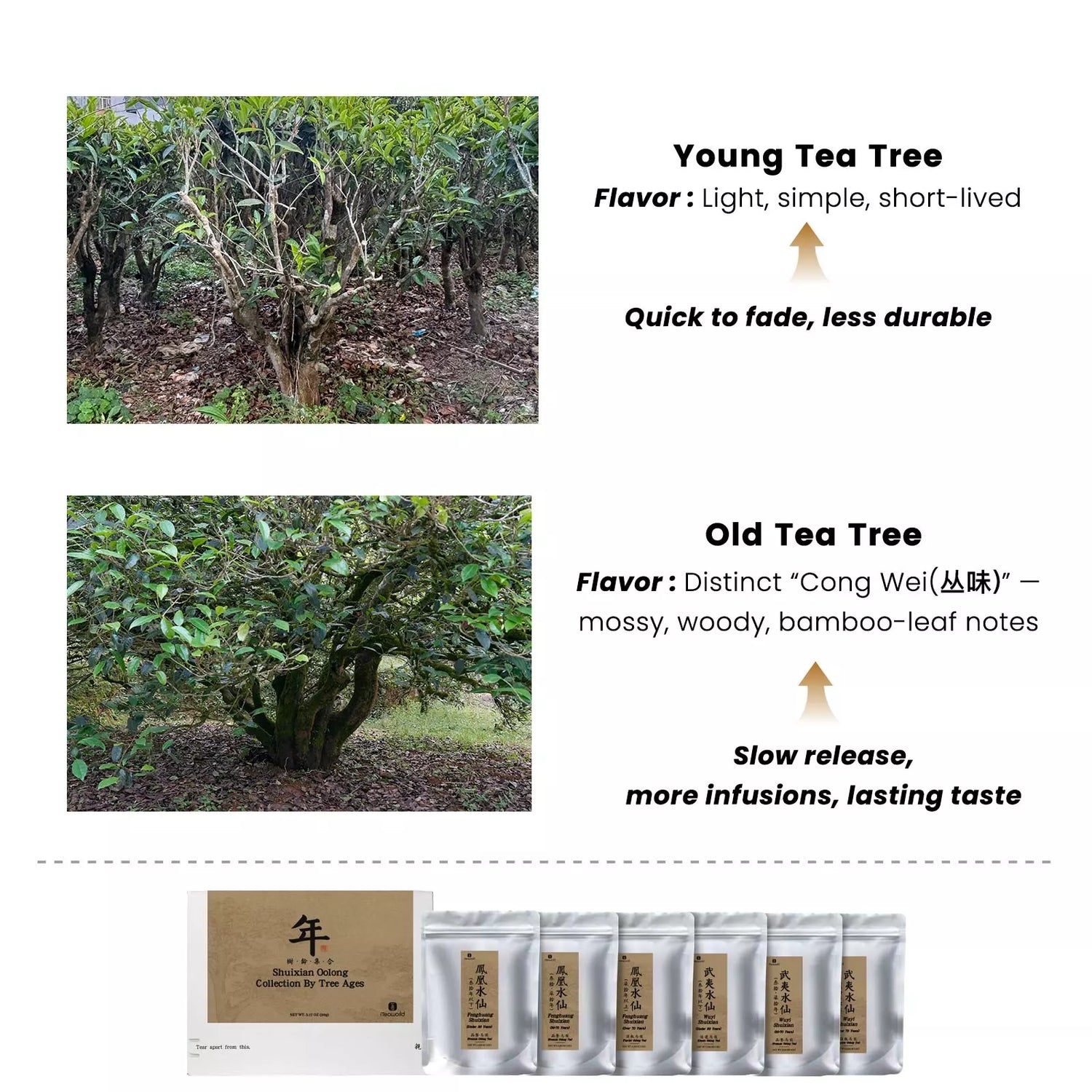

You Might Not Like Century-Old Tree Tea
Вам может не понравиться чай из векового дерева
И пуэр , и улун часто указывают на возраст дерева. Чай с более старыми деревьями встречается реже и стоит дороже, но не всегда пользуется спросом у всех.
- Молодые деревья : больше аминокислот → более сладкий вкус, более сильный сортовой аромат, но менее сложный.
-
Более старые деревья : богаче полифенолами, клетчаткой и минералами → более глубокая сладость, более продолжительное послевкусие, более стойкий, выдерживает многократные заваривания.
Возраст дерева особенно важен для шуйсяньских улунов (например, Феникс Шуйсянь, Уи Шуйсянь, Минбэй Шуйсянь).
В нашу коллекцию улунов «Шуйсянь» от Tree Ages входят чай «Феникс Шуйсянь» и «Уи Шуйсянь» из одного региона, изготовленный по одной и той же технологии, но из деревьев разного возраста, чтобы вы могли изучить, как возраст влияет на вкус.
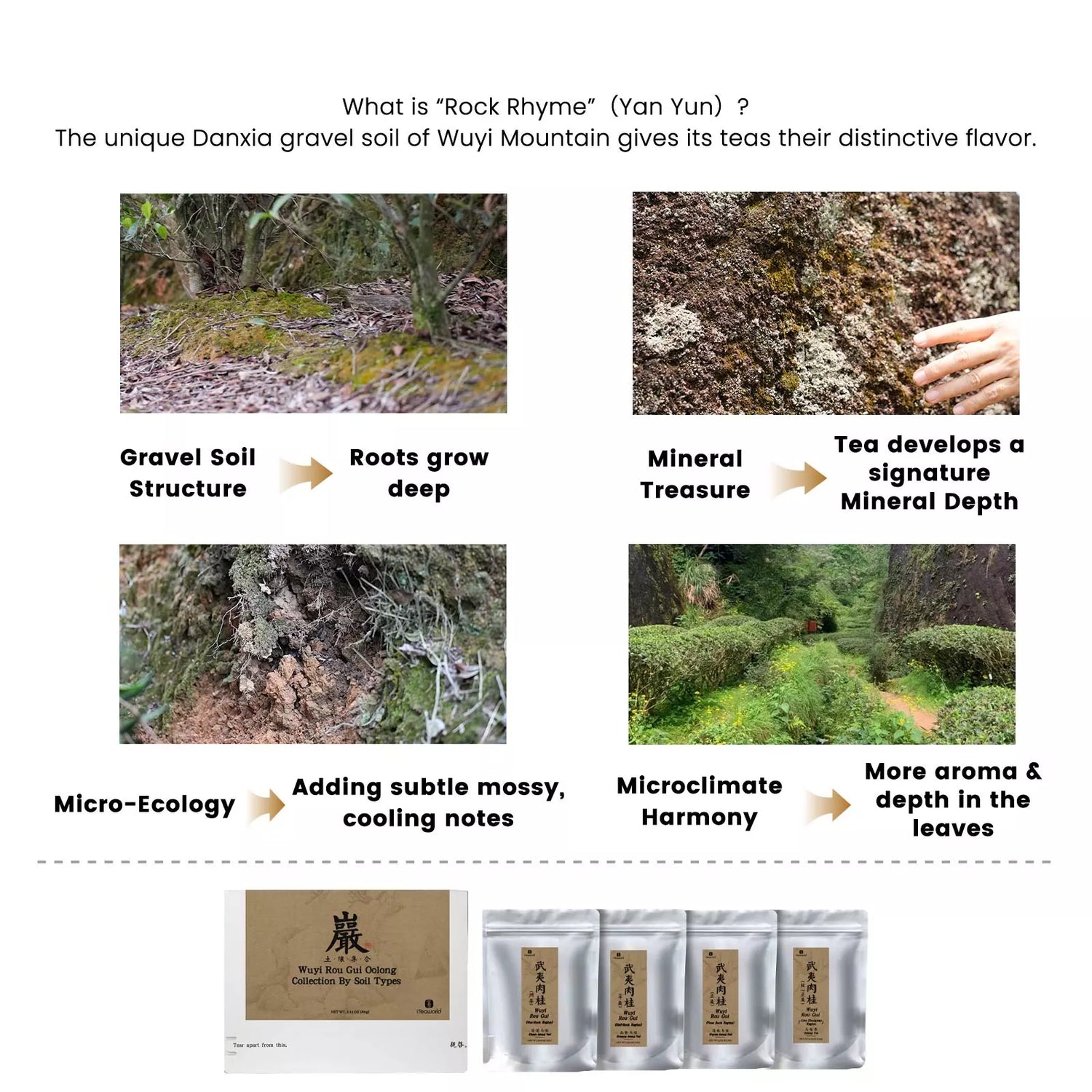

How Does Soil shape the Taste of Wuyi Rock Tea?
Как почва формирует вкус чая из Уишаньского утеса?
Более 1200 лет назад Лу Юй написал в «Классике чая»:
«Лучший чай растет на каменистой почве, чай среднего качества — на щебнистой почве, а чай более низкого качества — на желтой почве».
Чайные деревья прекрасно себя чувствуют в хорошо дренированной, богатой минералами почве, которая удерживает влагу, но не допускает заболачивания.
Каменистые и гравийные почвы → лучший баланс влажности и кислотности, что придает чаю Wuyi Rock характерный «рок-стих» (yan yun) и многослойный вкус.
Желтая почва → более простой вкус, без характерной каменистой ноты. (Этот сорт чая часто называют Чжоу Ча.)
В нашу коллекцию улунов Wuyi Rou Gui от Soils входят улуны Rou Gui из четырех различных почвенных зон — от самого ценного региона Core Zhengyan до более легкого региона Zhou Cha, — чтобы вы могли изучить, как почва формирует вкус.


What Really changes in Aged Oolong?
Что на самом деле меняется в выдержанном улуне?
Чтобы это выяснить, мы собрали пять улунов Миннань Шуйсянь (традиционный стиль обжарки на углях, с сильным ароматом) с зарубежной китайской чайной фабрики Юнчунь Бэйкэн, каждый из которых был собран в разном году: 1994, 2004, 2014, 2020 и 2024.
Со временем выдержанный улун преображается: аромат меняется со свежего, цветочного и фруктового на древесный и лекарственный. Вкус меняется от смелого и терпкого на мягкий, мягкий и сладкий. Чайный настой меняется от свежего до густого и бархатистого. Горечь исчезает, сладость становится глубже, а выдержанный аромат нарастает, словно изысканное вино, созревшее до чего-то глубокого и стойкого.
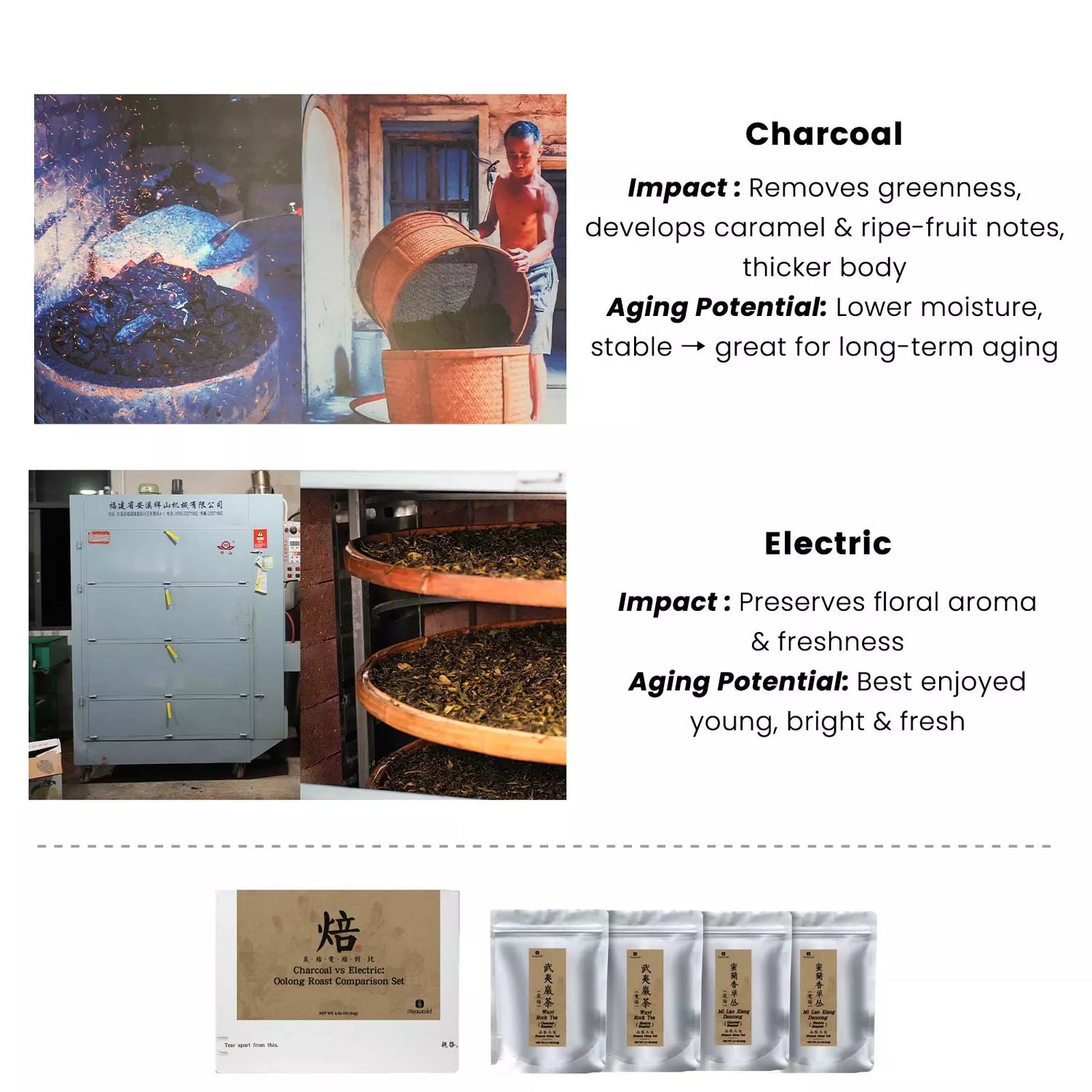

Charcoal vs. Electric Roasting – Two Ways to Shape Oolong’s Flavor
Обжарка на углях и электричество: два способа придать улуну особый вкус
Обжарка на древесном угле
Традиционный метод предполагает использование древесного угля из лонгана или личи для медленной низкотемпературной обжарки. Этот процесс — благодаря дегидратации, реакции Майяра и преобразованию аромата — создаёт:
- Аромат древесного угля, медовая сладость и минеральные ноты
- Блестящие чайные листья с насыщенным, многослойным ароматом
- Длительные заваривания (8+ раз)
- Идеальный потенциал старения
Подходит для таких чаев, как чай Уишань и Феникс Данцун , придавая им карамельную глубину и шелковистую текстуру.
Электрическая жарка
Современная обжарка использует нагревательные элементы и горячий воздух , что позволяет точно контролировать температуру (±5°C). Это:
- Эффективный и стабильный
- Лучше всего сохраняет яркие цветочные и фруктовые ноты в слегка окисленных улунах.
- Создает яркий аромат и чистый, освежающий напиток.
- Идеально подходит для употребления в течение 1–2 лет.
Наша коллекция
Чтобы подчеркнуть контраст, мы выбрали чаи от одного и того же чайного мастера, обжаренные как на древесном угле, так и на электричестве , чтобы вы могли почувствовать, как методы обжарки формируют вкус.






